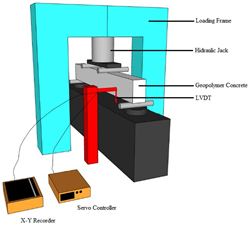An Experimental Study on the Mechanical Properties of Low-Aluminum and Rich-Iron-Calcium Fly Ash-Based Geopolymer Concrete
DOI:
https://doi.org/10.46604/aiti.2022.10525Keywords:
geopolymer concrete, fly ash, rich iron, low aluminum, mechanical characteristicsAbstract
Limited studies have been conducted on low-aluminum and rich-iron-calcium fly ash (LARICFA)-based geopolymer concrete with increased strength. This study aims to investigate the mechanical characteristics of LARICFA-based geopolymer concrete, including its compressive strength, split tensile strength, and ultimate moment. The steps of this study include material preparation and testing, concrete mix design and casting, specimen curing and testing, and the analysis of testing results. Furthermore, the specimen tests consist of the bending, compressive, and split tensile strength tests. The results show that the average compressive strength and the ultimate moment of the geopolymer concrete are 38.20 MPa and 22.90 kN·m, respectively, while the average ratio between the split tensile and compressive strengths is around 0.09. Therefore, the fly ash-based geopolymer concrete can be used in structural components.
References
M. D. Jackson, et al., “Phillipsite and Al-Tobermorite Mineral Cements Produced through Low-Temperature Water-Rock Reactions in Roman Marine Concrete,” American Mineralogist, vol. 102, no. 7, pp. 1435-1450, July 2017.
D. Reddy, et al., “Durability of Fly Ash-Based Geopolymer Structural Concrete in the Marine Environment,” Journal of Material in Civil Engineering, vol. 25, no. 6, pp. 781-787, 2012.
P. Chindaprasirt, et al., “Effect of Sodium Hydroxide Concentration on Chloride Penetration and Steel Corrosion of Fly Ash-Based Geopolymer Concrete under Marine Site,” Construction and Building Materials, vol. 63, pp. 303-310, July 2014.
M. S. Darmawan, et al., “Shear Strength of Geopolymer Concrete Beams Using High Calcium Content Fly Ash in a Marine Environment,” Buildings, vol. 9, no. 4, Article no. 98, April 2019.
Z. G. Ralli, et al., “State of the Art on Geopolymer Concrete,” International Journal of Structural Integrity, vol. 12, no. 4, pp. 511-533, 2020.
P. Duxson, et al., “Geopolymer Technology: The Current State of the Art,” Journal of Materials Science, vol. 42, no. 9, pp. 2917-2933, 2007.
M. Łach, et al., “Development and Characterization of Thermal Insulation Geopolymer Foams Based on Fly Ash,” Proceedings of Engineering and Technology Innovation, vol. 16, pp. 23-29, August 2020.
N. Zhang, et al., “On the Incorporation of Class F Fly-Ash to Enhance the Geopolymerization Effects and Splitting Tensile Strength of the Gold Mine Tailings-Based Geopolymer,” Construction and Building Materials, vol. 308, Article no. 125112, November 2021.
A. Fernández-Jiménez, et al., “New Cementitious Materials Based on Alkali-Activated Fly Ash: Performance at High Temperatures,” Journal of the American Ceramic Society, vol. 91, no. 10, pp. 3308-3314, October 2008.
M. Sambucci, et al., “Recent Advances in Geopolymer Technology. A Potential Eco-Friendly Solution in the Construction Materials Industry: A Review,” Journal of Composites Science, vol. 5, no. 4, Article no. 109, April 2021.
W. Kurdowski, Cement and Concrete Chemistry, Netherlands: Springer, 2014.
J. Temuujin, et al., “Influence of Calcium Compounds on the Mechanical Properties of Fly Ash Geopolymer Pastes,” Journal of Hazardous Materials, vol. 167, no. 1-3, pp. 82-88, August 2009.
T. Tho-In, et al., “Pervious High-Calcium Fly Ash Geopolymer Concrete,” Construction and Building Materials, vol. 30, pp. 366-371, May 2012.
T. Nongnuang, et al., “Characteristics of Waste Iron Powder as a Fine Filler in a High-Calcium Fly Ash Geopolymer,” Materials, vol. 14, no. 10, Article no. 2515, May 2021.
P. Venyite, et al., “Effect of Combined Metakaolin and Basalt Powder Additions to Laterite-Based Geopolymers Activated by Rice Husk Ash (RHA)/NaOH Solution,” Silicon, vol. 14, no. 4, pp. 1643-1662, 2021.
J. Davidovits, et al., “Ferro-Sialate Geopolymers (-Fe-O-Si-O-Al-O-),” https://www.geopolymer.org/news/27-ferro-sialate-geopolymers/, 2020.
K. C. Gomes, et al., “Iron Distribution in Geopolymer with Ferromagnetic Rich Precursor,” Materials Science Forum, vol. 643, pp. 131-138, March 2010.
N. Essaidi, et al., “The Role of Hematite in Aluminosilicate Gels Based on Metakaolin,” Ceramics Silikati, vol. 58, no. 1, pp. 1-11, July 2014.
J. C. Petermann, et al., “Alkali-Activated Geopolymers: A Literature Review,” Technical Report AFRL-RX-TY-TR-2010-0097, Air Force Research Laboratory, July 20, 2010.
P. Chindaprasirt, et al., “Effect of Calcium-Rich Compounds on Setting Time and Strength Development of Alkali-Activated Fly Ash Cured at Ambient Temperature,” Case Studies in Construction Materials, vol. 9, Article no. e00198, December 2018.

Published
How to Cite
Issue
Section
License
Submission of a manuscript implies: that the work described has not been published before that it is not under consideration for publication elsewhere; that if and when the manuscript is accepted for publication. Authors can retain copyright in their articles with no restrictions. is accepted for publication. Authors can retain copyright of their article with no restrictions.
Since Jan. 01, 2019, AITI will publish new articles with Creative Commons Attribution Non-Commercial License, under The Creative Commons Attribution Non-Commercial 4.0 International (CC BY-NC 4.0) License.
The Creative Commons Attribution Non-Commercial (CC-BY-NC) License permits use, distribution and reproduction in any medium, provided the original work is properly cited and is not used for commercial purposes.







